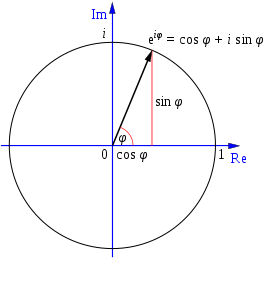List of representations of e
The mathematical constant e can be represented in a variety of ways as a real number. Since e is an irrational number (see proof that e is irrational), it cannot be represented as the quotient of two integers, but it can be represented as a continued fraction. Using calculus, e may also be represented as an infinite series, infinite product, or other sort of limit of a sequence.
| Part of a series of articles on the |
| mathematical constant |
|---|
 |
| Properties |
| Applications |
| Defining |
| People |
| Related topics |
As a continued fraction
Euler proved that the number e is represented as the infinite simple continued fraction[1] (sequence A003417 in the OEIS):
Its convergence can be tripled by allowing just one fractional number:
Here are some infinite generalized continued fraction expansions of e. The second is generated from the first by a simple equivalence transformation.
This last, equivalent to [1; 0.5, 12, 5, 28, 9, ...], is a special case of a general formula for the exponential function:
Conjectures
There are also continued fraction conjectures for e. For example, a computer program developed at the Israel Institute of Technology has come up with:[2]
As an infinite series
The number e can be expressed as the sum of the following infinite series:
- for any real number x.
In the special case where x = 1 or −1, we have:
- ,[3] and
Other series include the following:
- where is the nth Bell number.
Consideration of how to put upper bounds on e leads to this descending series:
which gives at least one correct (or rounded up) digit per term. That is, if 1 ≤ n, then
More generally, if x is not in {2, 3, 4, 5, ...}, then
As an infinite product
The number e is also given by several infinite product forms including Pippenger's product
where the nth factor is the nth root of the product
as well as the infinite product
More generally, if 1 < B < e2 (which includes B = 2, 3, 4, 5, 6, or 7), then
As the limit of a sequence
The number e is equal to the limit of several infinite sequences:
- and
- (both by Stirling's formula).
The symmetric limit,[7]
may be obtained by manipulation of the basic limit definition of e.
The next two definitions are direct corollaries of the prime number theorem[8]
where is the nth prime and is the primorial of the nth prime.
where is the prime counting function.
Also:
In the special case that , the result is the famous statement:
In trigonometry
Trigonometrically, e can be written in terms of the sum of two hyperbolic functions,
at x = 1.
Notes
- Sandifer, Ed (Feb 2006). "How Euler Did It: Who proved e is Irrational?" (PDF). MAA Online. Retrieved 2017-04-23.
- Gal Raayoni; et al. (Jun 2019). "The Ramanujan Machine: Automatically Generated Conjectures on Fundamental Constants". arXiv:1907.00205. Bibcode:2019arXiv190700205R. Missing or empty
|url=(help) - Brown, Stan (2006-08-27). "It's the Law Too — the Laws of Logarithms". Oak Road Systems. Archived from the original on 2008-08-13. Retrieved 2008-08-14.
- Formulas 2–7: H. J. Brothers, Improving the convergence of Newton's series approximation for e, The College Mathematics Journal, Vol. 35, No. 1, (2004), pp. 34–39.
- J. Sondow, A faster product for pi and a new integral for ln pi/2, Amer. Math. Monthly 112 (2005) 729–734.
- J. Guillera and J. Sondow, Double integrals and infinite products for some classical constants via analytic continuations of Lerch's transcendent,Ramanujan Journal 16 (2008), 247–270.
- H. J. Brothers and J. A. Knox, New closed-form approximations to the Logarithmic Constant e, The Mathematical Intelligencer, Vol. 20, No. 4, (1998), pp. 25–29.
- S. M. Ruiz 1997